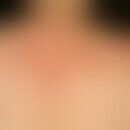DefinitionThis section has been translated automatically.
Keratolytic. Diureide of glyoxylic acid produced from uric acid by the enzyme uricase. In most animals (not in humans) it is the end product of the purine metabolism. Allantoin is found in a small number of plants, such as Symphytum offcinale (comfrey), horse chestnut bark and wheat germ.
Allantoin is soluble in cold water up to 0.5%, in hot water up to 4%.
Pharmacodynamics (Effect)This section has been translated automatically.
Is converted into urea on the skin, has a skin-soothing, keratolytic and granulation-promoting effect, increases the skin's ability to bind water.
The effect of fly maggots (fly maggots excrete allantoin) on infected wounds is based on the allantoin effect. This is also the case with comfrey root extracts.
You might also be interested in
IndicationThis section has been translated automatically.
Standard concentrationThis section has been translated automatically.
0.2-5% in water absorbing ointments (absorption bases), hydrophilic ointments, hydrophobic creams (W/O emulsion ointments), hydrophilic creams (O/W emulsion ointments), hydrogels and powders.
PreparationsThis section has been translated automatically.
Contractubex, Lipo Cordes cream, La Roche-Posay Xerand hand cream O/W emulsion





